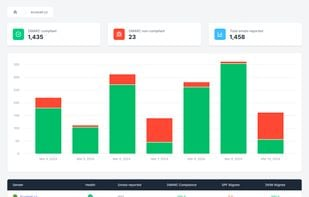Feature set
DMARCEye focuses on providing a streamlined DMARC reporting and analysis experience, particularly for those new to DMARC or managing fewer domains. The platform emphasizes AI-powered analysis to simplify complex DMARC data, making it easier to identify issues and understand recommendations.
While its Basic plan offers core monitoring, higher tiers like Scale and Enterprise unlock more advanced capabilities such as smart alerts, team integrations (Slack, Teams), multi-user access, and API access. We found its approach to be very user-friendly, translating technical DMARC reports into actionable insights without overwhelming us with unnecessary details.
DMARCly offers a comprehensive suite of DMARC-related features, going beyond basic reporting to include forensic reports, automatic subdomain detection, email vendor identification, and IP reputation monitoring. It's designed for organizations that require a deep dive into their email ecosystem.
Key differentiators include its Safe SPF feature for SPF flattening, BIMI support for brand recognition, and MTA-STS/TLS-RPT for enhanced transport security. We noted DMARCly's strong emphasis on security features like forensic report encryption and blocklist monitoring, making it a robust choice for security-conscious users. Its DNS timeline and DMARC/SPF/DKIM checker are also handy utilities.











































 4.5 / 5(1)
4.5 / 5(1)
 0 / 5(0)
0 / 5(0)



